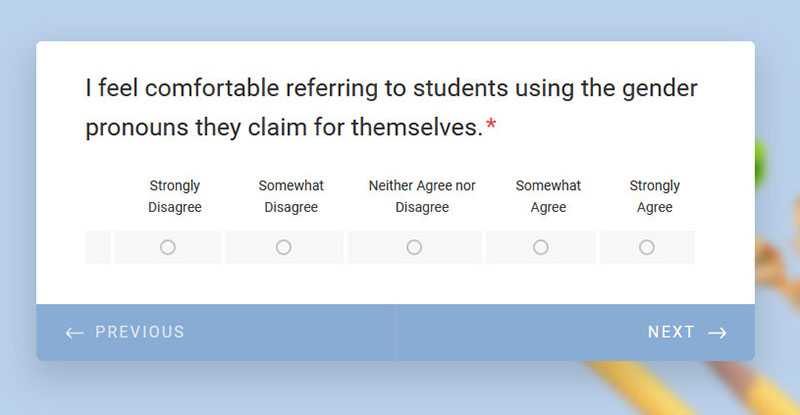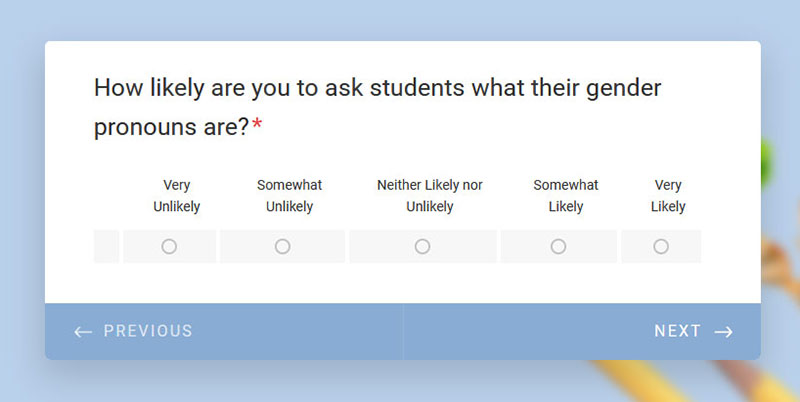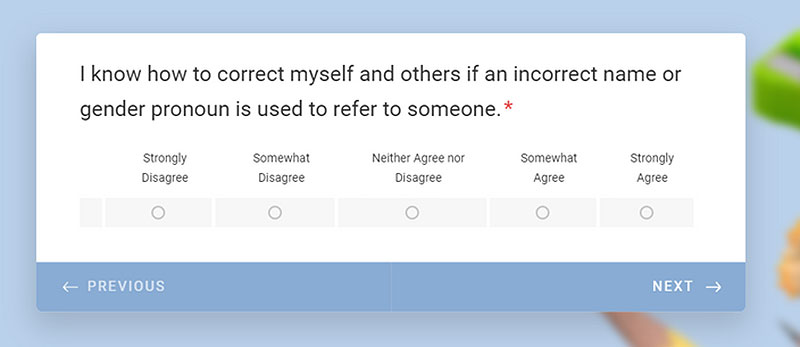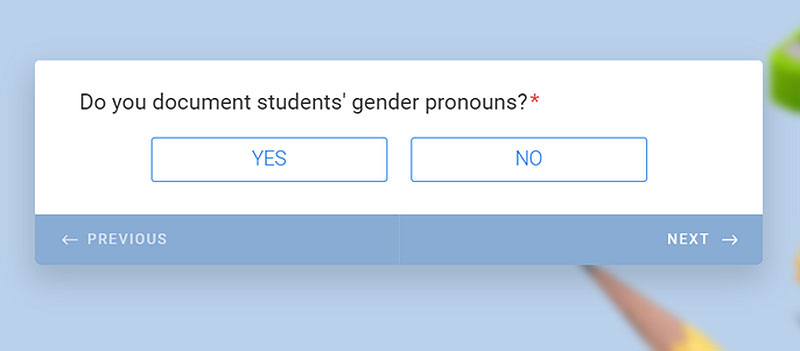our $100,000 MATCHING Challenge total!
Behind the Scenes:
How middle schools use aggressive surveys to indoctrinate teachers and coerce them to push the LGBT agenda on students
Shrewdly used as a psychological weapon and enforcement tool
Public unaware such surveys are imposed on staff
June 17, 2022
 Screenshot from the online survey given to teachers in Massachusetts middle schools.
Screenshot from the online survey given to teachers in Massachusetts middle schools. This is the first report in our series on insider material forwarded to us by teachers, parents, and local activists from across the country. You will learn what’s going on behind the scenes in your schools.
Many of us have seen the outrageous sex surveys that middle and high school students are given that include questions making deviant behavior appear normal to kids. But few parents are aware that the same technique is being used on the teachers in a powerful and psychologically devious manner.
In order to effectively push its agenda on children, the LGBT movement must force teachers to take many actions that may go against their nature. The first step is getting them to accept unscientific nonsense (especially regarding “gender”). Then, the teachers must be convinced to impose these beliefs on children.
As we described earlier, the teaching profession has been overwhelmed by dysfunctional people and committed radicals. Those teachers don’t need much of a push. But the teachers holding traditional values are the ones who must be intimidated and threatened.
The middle school teacher survey
Last month, a middle school teacher in Saugus, Massachusetts shared with MassResistance a disturbing survey that the teachers at her school were being asked to fill out. It was also given to teachers at another middle school nearby, and likely others.
The survey was written by the Everett LGBTQ+ Youth Space and Resource Center (ELYSRC), a slick “local” LGBT organization which clearly appears to be organized and funded by outside forces. The survey is not the work of amateurs. The questions are professionally crafted to intimidate, indoctrinate, and coerce into action.
The survey was divided into four sections which we’ve reproduced below. Throughout the survey, the required questions are followed by an asterisk.
The survey started by asking an optional question: “Do you identify as a part of the LGBT+ community?” If yes, they’re asked, “How do you identify? (ex. Lesbian, Non-binary, Queer, etc.)”
Section 1 is particularly heavy-handed. It starts the survey with some “enforcement” questions that are reminiscent of Maoist totalitarian regimes.
SECTION 1
In this section, you will determine the level to which you are likely to act in accordance with the following statements. (7 questions)
Pick from: Very Unlikely, Somewhat Unlikely, Neither Likely nor Unlikely, Somewhat Likely, Very Likely
- How likely are you to incorporate LGBTQ+ inclusive language into your teachings and interactions?*
- How likely are you to use gender-neutral pronouns when referring to someone you do not know (or whose gender pronouns you do not know)?*
- How likely are you to ask students what their gender pronouns are?*
- How likely are you to remember a student’s preferred name(s)?*
- How likely are you to correct a student if they use an incorrect name or gender pronoun to refer to someone else?*
- How likely are you to correct a colleague if they use an incorrect name or gender pronoun to refer to someone else?*
- How likely are you to intervene in situations where anti-LGBTQ+ behaviors and language are present?*
 A screenshot from the survey.
A screenshot from the survey.Section 2 enforces the teachers’ requirement to accept as truth the range of absurd, unscientific quackery that makes up today’s LGBT ideology. Also, keep in mind that until the homosexual movement terrorized the medical societies into changing their definitions, there was no such thing as “LGBT people” in medical terminology. Rather, they were considered to be heterosexual people with homosexual (or transgender) disorders. Also note that a question near the end appears to be an attempt to expose Christian teachers.
SECTION 2
In this section, you will determine the level to which you agree or disagree with the following statements. (36 Questions)
Pick from: Strongly Disagree, Somewhat Disagree, Neither Agree nor Disagree, Somewhat Agree, Strongly Agree
- I can confidently differentiate between gender, sex, and sexuality.*
- I am informed about the needs and experiences of LGBTQ+ people.*
- I can confidently direct LGBTQ+ students to relevant services and resources.*
- I am familiar with gender pronouns (including gender-neutral pronouns) and how to properly refer to folks with differing identities.*
- I feel comfortable asking students what their gender pronouns are.*
- I feel comfortable referring to students using the gender pronouns they claim for themselves.*
- I feel comfortable switching back and forth between different gender pronouns to refer to someone that has more than one.*
- I am familiar with neopronouns.*
- I feel comfortable using neopronouns.*
- I am informed about what “dead names” are.*
- I feel comfortable asking students about their preferred name(s).*
(A preferred name is a name that may differ from a name on legal documentation.) - I feel comfortable using students’ preferred names.*
- It is difficult for me to remember someone's gender pronouns or preferred name(s).*
- It is necessary to use the preferred name(s) and gender pronouns that a person tells me to use when referring to them.*
- People's names and pronouns can change at any time.*
- I know how to correct myself and others if an incorrect name or gender pronoun is used to refer to someone.*
- I am informed about LGBTQ+ inclusive language and how to use it.*
- I consciously and consistently incorporate LGBTQ+ inclusive language into my teachings and interactions.*
- I am informed about what language and behaviors would be considered anti-LGBTQ+.*
- I feel that anti-LGBTQ+ interactions frequently occur at my school.*
- I feel comfortable with intervening in situations where anti-LGBTQ+ language and behaviors are present.*
- It is my responsibility to follow through with reporting and monitoring instances of anti-LGBTQ+ behavior and language that I personally witness or that have been brought to my attention by a student.*
- I am informed about the laws that protect LGBTQ+ students in schools and my duties to uphold them.*
- I am informed about potential psychological and emotional effects of anti-LGBTQ+ environments on LGBTQ+ youth.*
(Anti-LGBTQ+ environments can include places where LGBTQ+ people are physically or emotionally harmed due to their identity or invalidated through misgendering or misnaming.) - I am informed about how other identities, like race and culture, affect the experiences of LGBTQ+ youth.*
- I feel confident supporting LGBTQ+ youth with multiple marginalized identities.*
(Marginalized identities are identities that are typically disadvantaged through structures of oppression, like race or gender discrimination. An example of a person with multiple marginalized identities could be someone who is both LGBTQ+ and a woman.) - I can tell what a person’s gender or gender pronouns are based on their appearance.*
- Our staff needs training on how to best support LGBTQ+ students.*
- I have been given the tools and support (from higher-ups) to make the best decisions regarding the needs of our LGBTQ+ students.*
- In this school, LGBTQ+ students do NOT face any safety concerns that are different from their non-LGBTQ+ peers.*
- In this school, LGBTQ+ students do NOT get treated any differently than their non-LGBTQ+ peers.*
- In this school, LGBTQ+ students are reprimanded more often than non-LGBTQ+ students.*
(i.e., dress code, truancy, behavior, etc.) - I have heard my co-workers use anti-LGBTQ+ language before.*
- One or more of my co-workers are unwilling to change their ways when told they are doing or saying things that are insensitive to the LGBTQ+ community.*
- My cultural and/or religious beliefs conflict with my ability to support LGBTQ+ students.*
- Anti-LGBTQ+ beliefs only negatively affect LGBTQ+ people.*
 A screenshot from the survey.
A screenshot from the survey.Section 3 goes further in coercing the ridiculous concept of “preferred gender pronouns” along with “preferred names.” Adopting these twisted language conventions has resulted in horrible and tragic mental health consequences for vulnerable middle school children, and has led to at least one federal lawsuit by parents. The idea that following these procedures actually “protects” children is preposterous. And it distracts teachers from the job they should be focused on: actually teaching. Note the reference in questions 4 and 5 to enforcement by the school administration.
SECTION 3
In this section, you will respond to questions with a definitive "yes" or "no."
(6 Questions)
- Do you share gender pronouns with students?*
- Do you document students’ gender pronouns?*
- Do you document students’ preferred names?*
If yes, how often do you document students’ preferred names?
(Options can include "at the beginning of each year," "when a student specifically requests it," etc.) - Do you follow a formal and uniform procedure to ensure that students’ gender pronouns and preferred names are documented and used by yourself and potential substitute teachers?*
(In this instance, "formal and uniform procedure" refers to a system or process that is school-wide, or widely practiced by you and your colleagues and is an expected standard that is enforced by your administration.) - Do you follow a formal and uniform procedure to ensure students' safety when using their preferred names and gender pronouns?*
(In this instance, "formal and uniform procedure" refers to a system or process that is school-wide, or widely practiced by you and your colleagues and is an expected standard that is enforced by your administration.) - Have you received bystander intervention training within the past two years?*
If yes, did the training incorporate tools and procedures for addressing anti-LGBTQ+ bullying and harassment?
If yes, how often do you share your gender pronouns with students?
(Options can include "at the beginning of each year," "when a student asks my pronouns," etc.)
If yes, how often do you document students' gender pronouns?
(Options can include "at the beginning of each year," "when a student specifically requests it," etc.)
 A screenshot from the survey.
A screenshot from the survey.Section 4 is distressing because it brings up outside-of-school “LGBTQ-related resources” which teachers are encouraged to steer children to, without parents’ knowledge. Note also that an upcoming “professional development workshop” will be on LGBTQ issues.
SECTION 4
In this section, questions are open-ended and to be answered in a short answer format. Questions are optional, you are not required to answer. (2 Questions)
- What are some of the LGBTQ-related resources you are aware of?
(This could be virtual or in person, provided by the school or an outside entity, or national or local.) - Do you have any LGBTQ-related concerns or questions you want to be addressed during our professional development workshop?
Final thoughts
This survey or similar ones are without a doubt being given in school districts across America.
Make no mistake: This kind of jack-booted pressure on teachers to twist the minds of our nation’s children – working hand-in-glove with the depraved LGBT movement – reflects the mindset of our educational establishment, including the Principals, guidance counselors, Superintendents, and administrators. That establishment is what MassResistance helps parents confront.
Coming next: There was a companion survey given to the middle school students at the same schools, written by the same LGBT organization – also without parents’ knowledge. Wait till you see that!
Please help us continue to do our uncompromising work!
Our successes depend on people like you.
Your support will make the difference!
